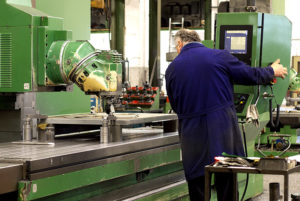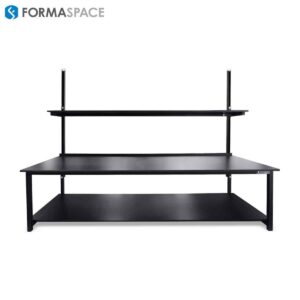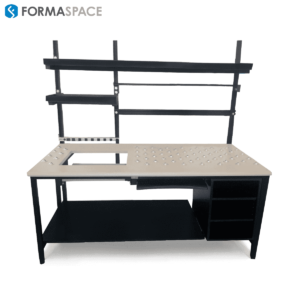The History of American Manufacturing
It is a perpetual political issue, and a mantra we’ve heard for decades now – manufacturers are sending American jobs overseas. The ‘Made in America’ label is becoming more and more rare. Over 5 million American manufacturing jobs have been lost since the turn of the century.

It hasn’t always been like this. American manufacturing was strong in the first half of the 20th century. In 1950, 48% of private sector jobs were in manufacturing. Large and successful corporations like Boeing, General Motors, Ford, and Maytag were proud to sport the ‘Made in America’ label. It was a label that meant quality and innovation. It brought us the Boeing 747, distinctive American cars like the Mustang and the Corvette, and modern household appliances. These large American manufacturers provided well-paying jobs that built the American middle class and led to the explosive growth of the American economy.
But, American companies were burdened with rising labor costs, increased regulation, and shareholder expectations of ever increasing profits. They began looking for ways to decrease their costs. A steady decline in American manufacturing began in the mid-1950s, and by 2010, only 17% of private sector jobs were in manufacturing.
The Current State of American Manufacturing
One of the most common ways American companies decreased costs was by outsourcing American manufacturing to lower cost countries. There are several apparent advantages to this.
- Labor is often the largest cost a manufacturer has, so by outsourcing to countries where labor is cheaper they can see significant cost savings.
- Some companies have decided that operating a manufacturing facility is not worth the trouble and have begun focusing on sales and marketing instead. They outsource product manufacturing to third parties, typically located overseas.
- The trend toward lean supply chains means that production capacity flexibility is important. Rather than risk idle capacity, flexible contracts with overseas third parties are attractive.

There are other impacts as well. Innovation, which has been the hallmark of American manufacturing, is now occurring within foreign manufacturing organizations – if it occurs at all. Trade secrets are stolen and used by unscrupulous foreign companies to counterfeit goods.
American companies hold their own operations to exceptional standards of health, safety, and environmental stewardship. But, it is difficult to regulate these things in overseas operations. Even quality can suffer when items are manufactured by employees with few skills and little training.
Why Bring Back the ‘Made In America’ Label?
It appears there are many advantages to outsourcing. Why should a company consider bringing back the ‘Made in America’ label?
Quality
Now more than ever, American consumers expect high-quality products and are willing to pay more for them. It is easier for American companies to ensure high product quality in manufacturing facilities within the United States than in distant countries.
Lead Times
It isn’t just consumers’ demands for quality that have increased. They also expect to get the product they want, when they want it. A company that runs out of stock is likely to lose the sale to a competitor. With products coming from the other side of the globe, the ability to react to sales fluctuations means needing to hold larger inventories. Modern understanding of lean supply chains frowns upon large inventories, and so do investors conscious of working capital levels.
Social Awareness
American companies put a lot of effort into making sure their overseas operations are complying with appropriate health, safety, environmental, and child labor standards. But, it is difficult to ensure compliance. As consumers become more aware of these issues, they demand greater assurance that these issues are being addressed. What better way to do that than to sport the ‘Made in America’ label?
Stability
Overseas manufacturing often occurs in countries with less stable political environments. And, even countries considered politically stable can experience unanticipated economic problems – like the UK after the recent Brexit vote.
How Do We Bring Back the ‘Made in America’ Label?
It isn’t all bad news. In fact, American manufacturing is getting stronger. A trend toward the ‘reshoring’ of manufacturing jobs has begun, and it is a trend that continues to grow. There are a few things that can be done to help keep the reshoring trend going.
- For all the historical difficulties employers have experienced with unions, it is important today to see unions as a partner. The relationship between unions and management must be strengthened. Both the union and the company must collaborate to provide high-quality
- Governments must remove the disincentives to American manufacturing. Tax rates must be brought in line with other countries, and tax incentives offered. Regulation must be kept reasonable. The cost of manufacturing in America must become more financially attractive.
- Modern manufacturers need highly skilled employees. Gone are the days where assembly line workers and production plant operators were simple ‘button pushers.’ Modern high-tech products require more skill to manufacture, so it is becoming more common to see well educated and trained line operators. Companies should ensure they are attracting these highly skilled employees, and it may require a higher wage than they have been paying.
- It is important to appeal to the social awareness of consumers. This can be done through advertising and proud ‘Made in America’ labels. As people become aware of the better working conditions in American manufacturing, the more they will seek out products made in America.
Do Your Part for American Manufacturing
The American economy will thrive as more manufacturing occurs here. Take Austin, TX, the hometown of Formaspace. Austin is the shining star of this movement. Being the number one contributor to the regional GDP, Austin generated $11.2 B with just the manufacturing industry. That is 10.3% of total regional GDP which is the largest share of any privately owned industry sector. Manufacturing is responsible for one out of every seven net new jobs created in the Austin economy and has a 7.6% annual growth rate. Austin manufacturing is adding jobs at a pace roughly 2.5 times that of the regional economy as a whole. That is a clear indication of a positive trend in the manufacturing industry. Long story short, there has never been a better time to bring manufacturing back to America!
The reshoring movement starts at home by building up our economy through job creation and purchasing from American manufacturers. Formaspace is a proud American manufacturing company in Austin, TX. We build custom business furniture for industrial, laboratory, and office clients. And, all Formaspace workbenches are built from materials sourced from local suppliers. Do your part to support American manufacturing by contacting your dedicated Formaspace Design Consultant today for your next business furniture project. It’s American to buy Formaspace.









